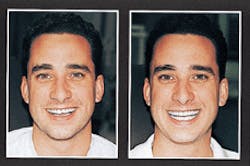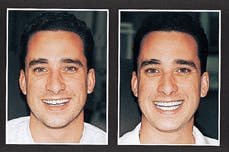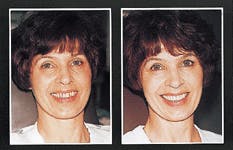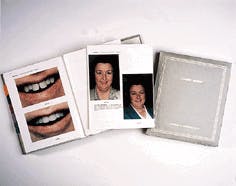The show me practice
Dental photographs that hang on walls, leap out from post cards and lure the loitering eye in waiting rooms serve the purpose of talking on your behalf.
Tom Hughes, DDS
Thirteen years ago, I decided to change the profile of my practice from "needs-driven" procedures to a "desire-driven" practice. During the transition years, I saw firsthand the tremendous impact that high-resolution dental photographs can have on the profitability of an adhesion/cosmetic practice.
Becoming heavily involved in dental photography was not something I set out to do. All I wanted was to offer my patients the best services I could and to assist them in making decisions that would improve the quality of their lives. After all, I was developing these wonderful new skills! I had fantastic new treatment alternatives to offer my patients, but, try as I might, I just could not communicate verbally the stunning effect that cosmetic dentistry could have on the overall beauty of their faces. What I discovered was that photographs do a better job of communicating my services than any other marketing tool possibly could.
Photos as a mission statement
There are several reasons why dental photographs are effective in helping a patient decide on an elective procedure. To make my points clearly, allow me to introduce you to dental photographs as my patients see them.
When patients come into my reception area, they see my mission statement - large post-operative photographs of smiling, happy patients with beautiful teeth. Low tables exhibit a collection of tastefully bound photo atlases instead of the usual plethora of well-worn magazines. Each atlas contains 12 sets of 8x10 before-and-after photos, side by side, which show the pleasing (and sometimes amazing) difference that cosmetic dental treatment can make.
The collection of atlases contains photos of men and women in all age ranges who have had cosmetic procedures. Patients considering these procedures can find someone they can relate to and thus visualize similar results.
A second bound book of photographs is more informative in nature. Simple text describes the cosmetic and restorative services we offer.
In the hallways on the way to the treatment rooms, the patients see more beautiful portraits of the post-operative and smiling people we`ve treated. While sitting in the chair in the treatment rooms, they also are given an opportunity to look through a collection of 8x10 before-and-after photographs, matted and framed to match the office decor.
I don`t have to tell you what many of my patients begin talking to me about when I enter the room. A number of patients will make general comments about the beauty of the photographs and then marvel about how cosmetic dental treatment can make such a profound difference on the overall appearance of a face.
Other patients may ask about a particular photograph and inquire about the treatment necessary to obtain the results. This allows me to respond to the patient and, in doing so, uncover any hidden concerns that individual may have about the appearance of his or her smile.
Let the patient lead!
Prompting the patient to begin the inquiry is, by far, the most important factor in utilizing the power of dental photographs. The patient is the one who should initiate the conversation. This is a subtle, but very important, difference than when the dentist initiates a conversation about, say, adhesion/cosmetic services. This progression allows the patient a level of comfort and confidence that is helpful when beginning a meaningful exploration regarding elective services.
Only after I began to use photographs did I notice how vastly different these exchanges were when the patient initiated a discussion about cosmetic procedures. Simply put, a dentist-initiated discussion is not an effective process. In fact, it`s presumptuous!
When patients are not prepared to talk about elective procedures, they may be taken aback or feel pressured. Patients who are sensitive about the appearance of their teeth suddenly may become self-conscious, hurt or even insulted. So, I was very happy to observe how the photographs created a more congenial and effective basis for discussion.
Before you think that the patients are overloaded with dental photographs, let me explain that I use no other art or adornments on the walls. Why should I pay money to hang a painting on the wall that would compete with my mission statement? Happy people with healthy and beautiful smiles are my specialty.
The photographs say it for me. They say that I care about my patients having beautiful, healthy smiles for a lifetime. The overall look created by the photographs is pristine, tasteful and professional. They are passive, non-intrusive, ever-present and subtle.
Other uses for photographs
Because these photographs were so successful and because my patients actually enjoyed looking at the results of treatment, I began to think about other marketing materials that were non-dental in nature, such as recall cards.
What do cartoon characters have to do with my dental expertise? Not a single thing! In fact, they communicate the opposite. So, I began to use recall cards with before-and-after photographs rather than cartoons. They, too, have increased treatment-acceptance rates. The recall cards get people to think and talk about elective dentistry even before they come in for their appointment.
Marketing desire-driven procedures calls for a much different mind-set than marketing a needs-driven dental practice. Needs-driven dentists compete with other needs-driven dentists. Lower fees, better payment plans, convenient locations and extended office hours (compared to the competition) are offered to attract and retain new patients.
Dentists with an elective focus, on the other hand, compete not so much with each other as they do with travel agencies, car dealerships, fine clothing stores and other businesses that compete for the customer`s discretionary dollars.
Marketing strategies change
This kind of thinking is difficult for many dentists because it calls for a paradigm shift. Marketing services that a patient wants is contrary to the kind of training we received in dental school. We were trained to think scientifically and technically and inform patients of the services they need. Whether they wanted them or not did not matter in our training and educational experience. Need was the focus.
The paradigm shift to desire-driven dentistry requires a fundamental change in marketing strategies. Once the change is made, the chance of returning to a strictly needs-driven practice is unlikely. Photographs are tools that can facilitate the shift to elective dentistry.
If you don`t show your patients what you can offer them, other benefits such as a convenient location or extended office hours will not be enough to get your current patients to seek elective treatments. Likewise, a good location and more hours of availability will not get potential patients who seek adhesion/cosmetic treatments to seek out your practice.
Patients who are ready, willing and able to pay for your services will do so only when they know what services are available. Therefore, we have to create the desire just like our competitors do. In a very real sense, we have to display our wares much like our competitors display their merchandise.
For example, when you walk into a fine clothing store, you see jackets tastefully displayed so that the customer can visualize how he/she might look with a certain style of shirt and tie. Car dealerships have photos of happy families in their vehicles. Similarly, model homes are nicely furnished so prospective buyers can visualize how their families might utilize the living space. Think about it. It`s just plain, good business to show your customers the types of services you can provide.
No high-pressure tactics
The above examples bring up another important point to keep in mind when marketing a higher-end discretionary service. People`s buying habits are much different when they are making a relatively large purchase (which many dental elective procedures are) than when they are considering a smaller purchase. Typically, the more expensive the purchase, the more sensitive a person is to pressure. People must be shown in a subtle, nonpushy way what options are available to them or they will feel pressured.
Attempting to persuade patients to undertake cosmetic procedures before they have truly considered it themselves is a big mistake. Patients sitting in a dental chair want to be assured that their dental health is uppermost in their dentist`s mind. Simply put, patients don`t want to be `sold` or persuaded to accept dental care. And, if you encourage a patient to accept elective care prior to that person independently deciding on the procedure, the final results will never be perceived to be ideal by the patient.
Test the concept on yourself. How do you feel when you walk onto a car lot and a salesperson approaches you and greets you with a typical opening question like: "What color car are you looking for today?" If you are like me, you interpret that question to mean "I`m going to sell you a car today, even if you have no intention of buying one." So, the standard reply to alleviate the pressure of the salesperson is, "I`m just looking."
Photographs are not threatening
Even writing about such scenarios puts me on the defensive; however, a salesperson posing the same kind of questions to sell you a toothbrush or a ballpoint pen is hardly worth mentioning. That interchange, while it may be unpleasant, does not evoke such a negative response because it is a low cost and insignificant decision.
The challenge, then, is for dentists with a cosmetic focus to give patients as much information as possible without verbally suggesting treatment. By doing this, dentists are ensuring that patients do not feel pressured during a discussion about elective care.
The reason tastefully displayed, high-quality dental photographs are so powerful is the absence of any kind of pressure. Because these photos are merely displayed, patients see them as nonthreatening and nonaggressive. Yet they are drawn to them. The photographs can have the same degree of attractiveness and magnetism as other objects of great beauty. The truth is that people are fascinated by them and actually enjoy looking at them.
But others who use dental photographs have found, as I have found, that the impact of the message is profound and can produce powerful results, even though the method of communication is passive.
This is because the simple act of viewing the photographs begins a process in which patients start to imagine, perhaps for the first time, that they can look better if they choose. They begin to imagine what it would feel like to be able to directly look at another person and confidently flash a big, gorgeous smile. The mere thought of this is enough to produce a smile on the spot and lift the spirits. Desire that has never been there before has been created. Latent desires have been awakened. Remember, `to visualize is to desire.`
Using photographs throughout a practice serves to quietly and continually nurture the idea of maximum cosmetic enhancement. Exposure to many different techniques assures patients that cosmetic dentistry is an established, state-of-the-art modality. The realization that recent technological advances are creating new, innovative cosmetic options creates an anticipating, exciting mind-set - a mind that is open to the same kind of possibilities that they see in the photographs.
When to use other media
For some practices, the use of photographs alone may be sufficient marketing to create the level of interest that will lead to a satisfactory number of cosmetic cases. Other dentists may wish to avail themselves of some of the more interactive systems (such as videos and computer programs on CD-ROM) that educate patients about cosmetic procedures. These, too, can be effective, provided that the patient is ready for cosmetic treatment - receptive to the idea of purchasing your services.
On the other hand, introducing patients to interactive technology before they are ready to buy your services has the potential to discourage them. The reaction is similar to that of the car customer who is `just looking.` The interactive technology could imply "too much pressure" to some patients. So exercise good judgment on which patients would benefit from these programs.
Powerful, but maintenance-free
In this regard, photographs can serve as an integral, basic component of a more sophisticated multi-media marketing effort. The photographs begin the process by creating a desire for cosmetic services in the patient`s mind. This prompts the patient to accept an interactive system for visualizing the effects and learning the details of modern treatments with less trepidation. The patient then will be able to get the greatest benefit from the interactive systems.
High-resolution dental photographs can be one of the best marketing investments cosmetic dentists can make. They are maintenance-free. They don`t have to be turned on and off. They work constantly in a way that is quiet, powerful and, most importantly, effective.
The fact that they are constantly working is especially important in the marketing of elective dental treatments, because the buying cycle or decision-making process most patients go through is a relatively long one. Photographs prompt the patient to ask questions and then the process of consideration begins.
I`ve seen the process first hand: Could an elective treatment make such a dramatic impact on my own face? What is involved? How much would it cost? Does the dentist offer financing options? How does purchasing this treatment fit into my budget this year, or the next?
The process takes time. If you are learning new techniques to offer your patients and think you should wait to use dental photographs as marketing tools, you will be behind in your marketing efforts.
Display photographs that are representative of the types of elective procedures you can offer as well as those you are learning to do. By the time your patients are ready to buy, you should be trained in the new procedures.
Simply put, it is more important from a marketing standpoint to show your patients what you can do than it is to show them what you have done. If you wait, you will have lost countless opportunities to perform elective treatment and, just as importantly, many of your patients will have waited needlessly to realize the exhilaration that comes when they finally decide to ask you to give them the beautiful smile they have always dreamed of. That is what makes our profession worthwhile!
Photos from other cases prompt some patients to inquire about possible options in elective treatment.
Atlases in a reception area can tastefully illustrate the benefits of cosmetic dental treatment. Each atlas above contains 12 sets of before-and-after photos.
Thomas E. Hughes, a dentist and photographer, has taken more than 27,000 high-resolution photographs of cosmetic and restorative procedures. He and his wife, Barbara, founded High Impact Marketing, a company dedicated to the concept of using photographs to enhance the practice of dentistry. High Impact Marketing offers a number of before-and-after atlases, photo recall cards, slide presentations, videos, and wall photos. To contact High Impact Marketing, call (719) 488-0808.




